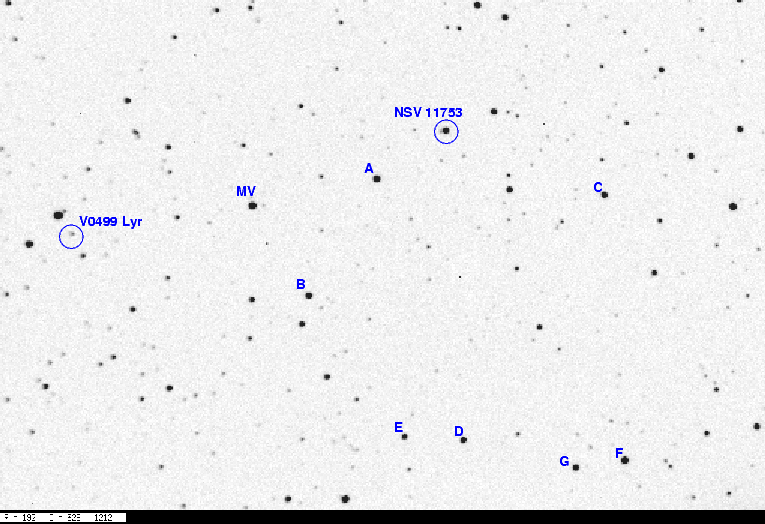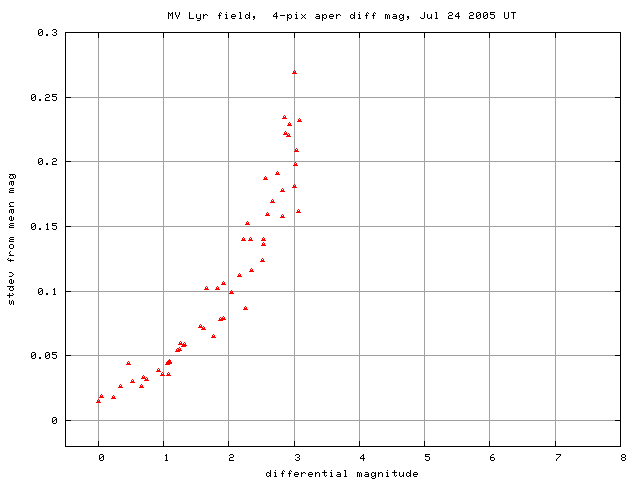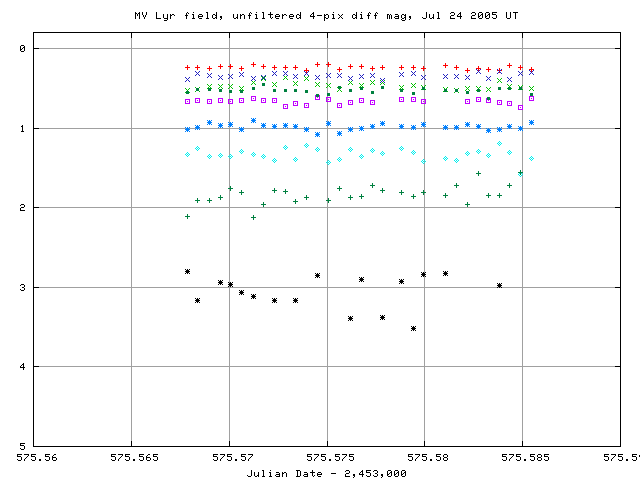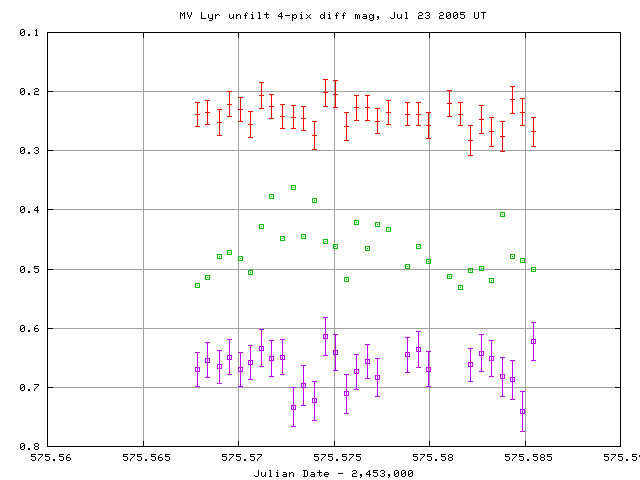
On the night of Jul 23/24, 2005 EDT, I used the RIT Observatory's 12-inch Meade telescope and SBIG ST8 CCD camera to monitor the cataclysmic variable star MV Lyr. This star is currently being monitored by the Center for Backyard Astrophysics. You can read Lew Cook's description of the system for very nice background information and an analysis of its behavior a few years ago.
The plan:
Notes from the night
Here's a chart of the field of MV Lry taken on UT Jul 23, 2005. The field is about 20 arcminutes wide. Click on the picture for a larger version.
The star marked "A" in the chart above is USNOB1.0 1367-0288714. It was measured by Henden and Honeycutt, PASP 107, 324 (1995), who found V = 12.518. Based on that value, and assuming that these unfiltered images have approximately a V-band passband, the variable MV Lyr was around V = 12.7 on this night.
I measured the instrumental magnitude of each star with aperture photometry, using a radius of 4 pixels = 7.4 arcseconds, and sky defined by an annulus around each star. Following the procedures outlined by Kent Honeycutt's article on inhomogeneous ensemble photometry, I used all stars available in each image to define a reference frame, and measured each star against this frame.
Below is a graph of the scatter in differential magnitude versus magnitude.

MV Lyr is the star near differential mag 0.5, with an elevated scatter. You can see how poor the night was, as the floor in the scatter of the brightest stars is about 0.020 mag (versus 0.004 mag on a good night); note also how small the range of differential magnitudes is -- on a good night, we can measure down to 5 magnitudes below the peak.
Light curves for selected stars in the field are shown below. The large scatter in all measurements hides the variability fo MV Lyr on this scale. The black points around differential magnitude 3 are those of V0449 Lyr; on the previous night, it was fainter, rising from 4 to 3.5 magnitudes below the brightest stars in the field. If we can continue to include this star in the field while monitoring MV Lyr, we might be able to answer a few of the questions Lew Cook raises in his report on photometry of V0449 Lyrae.

Here's a closeup of the variation in MV Lyr itself:

It's hard to say if any of the features in this tiny slice of the light curve are real. Sigh.
I've made a table of the measurements themselves, with three different flavors of time. The differential unfiltered magnitudes from the ensemble solution has been shifted so that star "A" in my chart, has value 12.518, matching its V-band magnitude as determined by Henden and Honeycutt.
Here's the start of the table:
# Measurements of MV Lyr made at RIT Obs, Jul 24, 2005 UT, # made by Michael Richmond in very poor conditions. # All data taken with 12-inch LX-200 + no filter + SBIG ST-8 CCD # no focal reducer, so at native f/10 # Each exposure 30 seconds long; tabulated times are midexposure # and accurate only to +/- 1 second. # 'mag' is a differential magnitude based on ensemble photometry # which has been shifted so USNOB1.0 1367-0288714 has mag=12.518 # (the V mag from Henden and Honeycutt, PASP 107, 324, 1995). # # UT day JD-2,450,000 HJD-2,450,000 mag uncert Jul24.06785 3575.56785 3575.57026 12.807 0.031 Jul24.06839 3575.56839 3575.57080 12.794 0.032 Jul24.06899 3575.56899 3575.57140 12.759 0.038
Last modified 7/24/2005 by MWR.